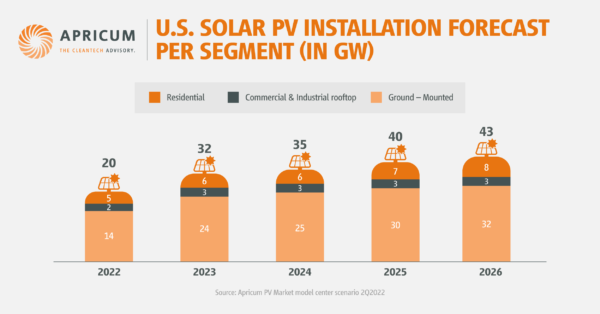In this article we look beyond the headlines of the Inflation Reduction Act and at some of its pitfalls and direct opportunities for solar developers. Apricum is best known in Europe and the Middle East, but the US represented 25% of group revenues last year. Our development clients eyeing the US should be mindful of the complexity in capturing these IRA-led opportunities. Solar development is not an all-you-can-eat feast; familiar challenges mean only a few strategies are likely to yield immediate results when trying to capitalize on these opportunities.
The IRA has tilted the renewables industries on their axis. Many clients now debate the merits of US expansion: 10 years of policy certainty, with higher asset values, ends the inefficient policy lapse and extension cycle to allow developers, investors and other stakeholders to make longer term plans.
However, just like in Europe, supply chain constraints, long interconnection queues, and rising interest rates all create challenges to building successful projects and add uncertainty. Capturing the opportunities will require greater strategic insight than in other booming markets.

Source: Apricum PV market model center scenario 2Q2022
- Interconnection queues drive project timelines in the US and are the leading cause of project failure in most markets. These processes and issues are very different across the spectrum of vertically-integrated utilities, Regional Transmission Organizations and Independent System Operators (RTO’s/ISO’s) that lay across the US in patchwork fashion. Some ingenious and nimble strategies can be deployed by astute developers to circumvent the resulting project delays that otherwise occur from sticking with the standard utility-scale development template. Picking sub-markets and selective strategies are critical to success. For example, projects connecting at distribution voltage below 69kV can go through local interconnection processes more quickly because they are subject to state rather than federal regulation. In markets such as Virginia, PPAs can be secured with both corporate buyers or large utilities like Dominion Energy, allowing developers to complete the ISO processes in PJM at a later date to provide additional offtake options.
- Certain IRA financial incentives subject projects to stringent local content requirements. In order to qualify for an additional 10% tax credit, local content must constitute 40% of the project if starting construction before 2025, rising by 5% per year to 55% for projects starting construction in 2028. Companies eyeing tax incentives can face bureaucratic hurdles, without in-house/external expertise that understands these supply chain implications.
- The IRA simplifies tax credit transferability between taxpayers, reducing the need for complex partnership flip structures and five-year hold periods. Projects can be designed for RTB or COD sale in a more straight-forward manner.
While the IRA has national application, this does not diminish the need for local market sensitivity. Some stackable IRA incentives will also only apply to local communities (ie:+10% for low-income or fossil fuel dominant communities). But the largest impact is from local energy market design and policies. Below we review the top four below with a developers’ eye.
- ERCOT
The majority of the Texas population is served by ERCOT, an independent grid insulated from the rest of the country. Within ERCOT, which is not subject to federal regulation, developers generally have more flexibility in deploying infrastructure. The Lone Star state has a geographically zonal market structure, presenting very different opportunities for projects. Historically dominated by wind, in recent years solar and battery storage have grown rapidly. Unique characteristics such as a lack of capacity market, a highly open and competitive retail energy market, and the ability to build private-use networks, mean projects in Texas have unique requirements. For instance, many projects are financed using hedges instead of a PPA, or a PPA only for a portion of the total capacity, running the additional capacity as merchant power to capture spot market pricing that can be as high as $5,000/MWh during periods of high demand.
- PJM
PJM is the largest system operator in the US. It is part of the Eastern Interconnection grid operating an electric transmission system serving all or parts of Delaware, Illinois, Indiana, Kentucky, Maryland, Michigan, New Jersey, North Carolina, Ohio, Pennsylvania, Tennessee, Virginia, West Virginia, and the District of Columbia. Most large projects in PJM were given two year delays in mid-2022 while a new interconnection process was implemented. This pushed almost half of projects in development out to the 2025-26 timeframe. The result is an opportunity for patient capital, such as new market entrants from Europe, to cheaply acquire partially-developed projects whose domestic appeal has diminished with the later connection dates. Additional opportunities exist for projects connected at the distribution level with utilities in specific state markets. PJM projects in particular benefit from sourcing short-term PPA’s with local utilities prior to broader market access.
- CAISO
Historically one of the largest and most active markets for solar in the world, recent years have seen extraordinary growth of renewable projects paired with storage in California. The rise of Community Choice Aggregators is challenging the status of the big three in-state regulated utilities [PG&E/SoCalEdison/San Diego Gas & Electric] and creating opportunities for new contracts/customers. This is not as easy a market as new entrants assume. Challenges around credit and structuring exist with CCAs, and it’s never easy to surmount permitting obstacles for new projects of any type anywhere in California.
- NYISO
Like California and Texas, New York has its own single-state system operator, making project development somewhat more straightforward. Like California, New York has strong renewables and energy storage ambitions in pursuit of aggressive decarbonization targets. Unlike the other states, opportunities for the largest solar developers are limited: insolation quality is mediocre, and there are few sizable parcels of land suitable for large-scale PV deployment. However, community solar and behind-the-meter markets are fairly robust, spurred by leading distributed energy resources (DER) pricing policies. Moreover, given New York’s plans to add 9 GW of offshore wind by 2035, as well as significant intrastate transmission bottlenecks constraining the ability to serve New York City, the need and value associated with energy storage assets is profound.
Jesse Atkinson is senior advisor and country representative USA, for Apricum Group. He is the former president of Cratus Energy and board member of Alion Energy.
Richard Stuebi is senior advisor for Apricum Group. He was also founder and president, Future Energy Advisors; former board member ESA; former VP, US strategy & group technology, National Grid; managing director, Early Stage Partners.
The views and opinions expressed in this article are the author’s own, and do not necessarily reflect those held by pv magazine.
This content is protected by copyright and may not be reused. If you want to cooperate with us and would like to reuse some of our content, please contact: editors@pv-magazine.com.








In California solar is currently property tax exempt for the first installing owner. Considering installing solar on residential rentals but hearing rumblings of the property tax exemption going away and probably would not do it if that is the case. Hoping for a reassuring article.
Net Metering is also going away under NEM 3.0 where the utility gets to keep, without compensation 75% of what you produce and put onto the grid during the day, and you have to buy it back at 4 times what NEM 2.0 customers pay at night. With rooftop solar, in the USA, getting hammered by utilities that no longer want to use Net Metering, I feel this article is overestimating the rooftop portion of solar expansion especially since California is usually half of all new rooftop solar installations in America.
Solar development is indeed not an all-you-can-eat feast as there are many pitfalls before you have a completed functional system.